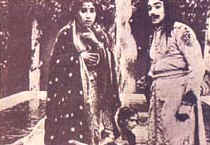
Scene from the film
'Raja Harishchandra'.
|
RAJA
HARISHCHANDRA - THE STORY
After a fortnight's stay in London, Phalke set sail for India
fully confident and armed with the knowledge that he could make a feature film. He touched
Bombay on April 1,1912— exactly 48 days before Torney's Pundalik was released at the
Coronation Cinema. Whether Phalke ever saw this film is not recorded but a man so swept
with the idea of making a feature film could not have missed noticing this effort which
promised to eclipse his own. In any case, Phalke must have been far too busy to give the
film a second thought for his real troubles began now.
Finance — this time to make the film — was still his
insurmountable obstacle. With his newly acquired Williamson camera Phalke filmed another
test short: a 100/200 foot film with his wife and children as artistes. This short gave
his financier renewed courage and finance was made available but only against security.
This was when Kaki Phalke, like a true dutiful Indian wife, offered her ornaments as a
security for the loan, giving rise to this legend which is quoted even today in film
industry circles.
There were other problems, the principal one being the dearth of
artistes willing to work in films because of the stigma attached to the profession. Phalke
took out a series of advertisements in Induprakash, a well-circulated Marathi newspaper of
that time, welcoming auditions from "handsome faces". Only third-rate stage
artistes applied. Finding women artistes was an even tougher job. Phalke even scoured
red-light areas for suitable women artistes but did not meet with much success. Eventually
he had to be satisfied with casting the slightly built Salunke as Taramati. D.D. Dabke was
cast as Harishchandra while Phalke's own son Bhalchandra played Rohidas.
The actual production problems were even more complex. Shooting
for Raja Harishchandra began soon after the monsoon of 1912 at the bungalow owned by
Mathurdas Monji Waiji on Dadar Main Road, Phalke had to do everything: teach acting to the
artistes, write the scenario, design and erect the set, direct the film and do the
filming. That apart he had to work round the clock: shoot during the day and perforate the
negative, develop the exposed film, print and edit it during the night. There was no
alternative because no one really knew anything about making feature films.
Six months later, an edited 3700 feet of Raja Harishchandra was
ready. Canny as usual, Phalke wrote the subtitles of the film in Hindi and English so as
to reach the widest possible audience. Phalke's dream of producing a story-film like The
Life Of Christ had come true. He arranged a preview of the film on April 21, 1913 at the
Olympia cinema in Bombay (or the elite of the city. The film was commercially released on
May 3, 1913 at the Coronation cinema.
The first response to Dadasaheb Phalke's Raja Harishchandra was
not an enthusiastic one. People just could not believe that a feature-length film could be
made by an Indian and thought it was some kind of a hoax. Or probably the curt single line
"double admission rates will be charged" at the end of the advertisements proved
to be a dampener. Indian audiences were used to paying half the price they paid for an
ordinary cinema ticket to watch an all-night musical stage play. For them the charge of
two annas for a mere 40-minute entertainment was ludicrous.
Phalke realised all this instinctively and decided that without
the right marketing his film would be a eb Phalke. non-starter. The first thing that he
did was to arrange a 10-15 minute dance programme by two European girls for the crucial
first few days. Outside Bombay he tried to appeal to the masses by changing the tone of
his advertising, which now began to stress that the film contained 50,000 "still
photographs" (frames) and ran to a length of two miles. Written in this manner, the
film seemed immensely long and the audience felt that it was getting its money's worth.
Finally, Phalke invited the representatives of leading
newspapers to witness the show free, thus starting the practice of having press shows. The
press was naturally enthused and wrote about the film in glowing terms. The Bombay
Chronicle described it as "the first great Indian dramatic film" and "a
remarkable triumph". The campaign was an immediate success. Crowds thronged to the
theatre and the film was well on its way to becoming the legend that it is today. It must
be underscored at this juncture that Phalke's intrinsic product was a good one and hence,
his hard sell yielded results. For example, his trick scenes — created with a simple
hand-operated camera and a black curtain — compare quite favourably with those
created today. Phalke had also instinctively realised what the earlier pioneers had failed
to understand: that it was not enough to produce a good film, it was more important to
market it properly. He thus became his own distributor.
|

